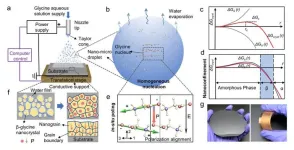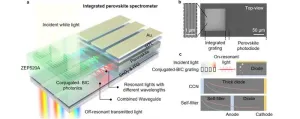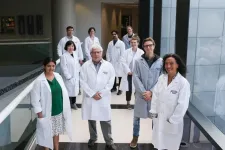(Press-News.org) PULLMAN, Wash. -- Restaurants can persuade patrons to choose healthier foods by adjusting the font size of numbers attached to nutritional information on menus, according to a study headed by a Washington State University researcher.
Lead researcher Ruiying Cai, an assistant professor in the WSU School of Hospitality Business Management, said U.S. restaurants with more than 20 locations are already required to show the calorie content of food on their menus. By representing these values incongruously — using physically larger numbers on the page when they’re attached to lower-calorie options, and smaller numbers for high-calorie foods — Cai said businesses can successfully “nudge” customers toward healthier choices.
“When restaurants use a larger font size for the calorie content of healthy foods, even though the number itself has a smaller value, it will increase consumers’ preference to order the healthier item,” Cai said.
For the study, recently published in the International Journal of Hospitality Management, participants were asked to choose between a less healthy item like a smoked beef burger and a healthier option like a grilled chicken sandwich. They were then randomly assigned to two groups. In the first group, number values and font size rose and fell together. In the second group, the relationship between the numbers’ magnitude and their size was incongruent, meaning the font size became smaller as the number values rose and vice versa.
Researchers also posed questions to gauge how health-conscious participants were and gave varying time limits to some to measure the effect time constraints have on their decisions. Cai said the study results showed that participants in second group, who saw low calorie counts printed in large fonts, were more likely to lean toward the healthier option. Respondents who indicated they were less health-conscious were also the most affected, particularly when there was a tight timeframe to make the choice.
People who had a high level of health awareness were less likely to be swayed, Cai said, but this is likely because they already favored healthy food.
“Even if you use some of the smart tricks, it does not work as well as for those who are not so knowledgeable about health,” Cai said.
The study leverages a phenomenon called the “numerical Stroop effect,” which uses incongruity to emphasize the lower numbers and slightly slow the decision-making process, to help coax customers toward healthier menu options.
In its classic form, the Stroop effect is described as a delay in reaction time related to stimuli. For example, if the word “purple” is written in green font, it takes respondents longer to call out which color they’re seeing than if the word and the color match. Clinicians use this principle to measure attention capacity and processing speed in patients. Similarly, the numerical Stroop effect is observed when the physical size of the number does not match its actual magnitude — as when the number 50 is in a larger font than the number 80.
Restaurants have an interest in encouraging patrons to make healthier choices, Cai said. However, simply labeling the food as healthy may not have the intended effect.
“Healthy food items could be profitable for restaurants, but whenever a ‘healthy’ label is attached, people may assume it does not taste good,” she said. “We're trying to provide restaurants with subtle cues, rather than saying it out loud.”
Cai's coauthors were Laurie Wu and WSU alumna Lu Lu; both are associate professors at Temple University's Fox School of Business.
END
Font size can 'nudge' customers toward healthier food choices
2023-08-10
ELSE PRESS RELEASES FROM THIS DATE:
Researchers unlock mystery of cartilage regeneration in lizards
2023-08-10
A team of researchers from the Keck School of Medicine of USC have published the first detailed description of the interplay between two cell types that allow lizards to regenerate their tails. This research, funded by the National Institutes of Health and published on August 10 in Nature Communications, focused on lizards’ unusual ability to rebuild cartilage, which replaces bone as the main structural tissue in regenerated tails after tail loss.
The discovery could provide insight for researchers studying how to rebuild cartilage damaged by osteoarthritis in humans, a degenerative and debilitating disease that affects about 32.5 million adults ...
Space weather and satellite security: Graz University of Technology and University of Graz supply new forecasting service for the ESA's Space Safety Programme
2023-08-10
After a successful test phase, the Satellite Orbit DecAy (SODA) service, which was jointly developed by TU Graz and the University of Graz, officially became part of the ESA’s Space Safety Programme in mid-July. SODA provides accurate forecasts of the effects of solar storms on low Earth orbiting satellites. This makes TU Graz only the third Austrian institution contributing to this ESA programme. Seibersdorf Laboratories, and the University of Graz, through the Kanzelhöhe Observatory and the Institute of Physics, ...
New high-tech microscope using AI successfully detects malaria in returning travelers
2023-08-10
Each year, more than 200 million people fall sick with malaria and more than half a million of these infections lead to death. The World Health Organization recommends parasite-based diagnosis before starting treatment for the disease caused by Plasmodium parasites. There are various diagnostic methods, including conventional light microscopy, rapid diagnostic tests and PCR.
The standard for malaria diagnosis, however, remains manual light microscopy, during which a specialist examines blood films with a microscope to confirm the presence of malaria parasites. ...
HKUST researchers pioneers technique to self-assemble high-performance biomolecular films
2023-08-10
A research team led by The Hong Kong University of Science and Technology (HKUST) has developed a novel technique to self-assemble a thin layer of amino acids with ordered orientation over a large area that demonstrates high piezoelectric strength, making the manufacturing of biocompatible and biodegradable medical microdevices, such as pacemaker and implantable biosensor, in the near future possible.
The generation of bioelectricity from the piezoelectric effect – reversible conversion between mechanical and electrical energies – has physiological significance in living systems. ...
A platform for integrated spectrometers based on solution-processable semiconductors
2023-08-10
Acquiring real-time spectral information in point-of-care diagnosis, internet-of-thing, and other lab-on-chip applications require spectrometers with hetero-integration capability and miniaturized feature. Compared to conventional semiconductors integrated by heteroepitaxy, solution-processable semiconductors provide a much-flexible integration platform due to their solution-processability, and, therefore, more suitable for the multi-material integrated system. However, solution-processable semiconductors are usually incompatible with the micro-fabrication processes, making them far from practical use in various lab-on-chip applications.
In a new paper published ...
Researchers develop novel technology to quantify protein critical to blood clot formation through breath gas analysis
2023-08-10
Immunothrombosis, or the formation of microscopic blood clots during inflammation, is a major cause of morbidity among patients with sepsis or severe COVID-19. A key enzyme in this process is thrombin. To date, no method exists for early detection of immunothrombosis in a living organism.
A team of investigators led by Ali Hafezi-Moghadam, MD, PhD, director of the Molecular Biomarkers Nano-Imaging Laboratory (MBNI) at Brigham and Women’s Hospital, a founding member of Mass General Brigham healthcare system, and an associate professor of Radiology at Harvard Medical School, developed a novel technology to diagnose immunothrombosis by measuring ...
C-Path welcomes Sanofi to its Type 1 Diabetes Consortium to help advance drug development
2023-08-10
TUCSON, Ariz., August 9, 2023 — Critical Path Institute (C-Path) announced today that Sanofi, a global leader in immunology and diabetes care, has joined its Type 1 Diabetes Consortium (T1DC). Sanofi joins T1DC as part of its commitment to push the boundaries of innovation to improve the lives of those with diabetes.
T1DC was established in 2017 with the goal to significantly advance the drug development landscape for T1D prevention and treatment. The consortium achieves this by fostering ...
How sure is sure? Incorporating human error into machine learning
2023-08-10
Researchers are developing a way to incorporate one of the most human of characteristics – uncertainty – into machine learning systems.
Human error and uncertainty are concepts that many artificial intelligence systems fail to grasp, particularly in systems where a human provides feedback to a machine learning model. Many of these systems are programmed to assume that humans are always certain and correct, but real-world decision-making includes occasional mistakes and uncertainty.
Researchers from the University of Cambridge, along with The Alan Turing Institute, Princeton, and Google DeepMind, have been attempting ...
Large study suggests people with low levels of vitamin K have less healthy lungs
2023-08-10
People with low levels of vitamin K in their blood are more likely to have poor lung function and to say they suffer with asthma, chronic obstructive pulmonary disease (COPD) and wheezing, according to a study published today (Thursday) in ERJ Open Research [1].
Vitamin K is found in leafy green vegetables, vegetable oils and cereal grains. It plays a role in blood clotting, and so helps the body to heal wounds, but researchers know very little about its role in lung health.
Researchers say their new findings do not alter the current advice on vitamin K intake, but they do support further research to ...
Sanford Burnham Prebys Cancer Center earns merit extension from NCI
2023-08-10
Sanford Burnham Prebys’ Cancer Center has received a rare and prestigious Merit Extension Award from the National Cancer Institute (NCI), recognizing and rewarding its earlier accomplishments as well as current research plans. The award extends the center’s current 5-year Cancer Center Support Grant (CCSG) for an additional two years.
There are only seven Basic Laboratory Cancer Centers in the NCI’s national network. These centers focus primarily on laboratory research: developing, conducting, translating and advancing fundamental discoveries to clinical testing and, ultimately, ...





